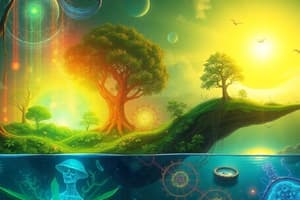Podcast
Questions and Answers
What is the name of the green pigment found in leaves that allows for photosynthesis?
What is the name of the green pigment found in leaves that allows for photosynthesis?
- Carotene
- Melanin
- Chlorophyll (correct)
- Anthocyanin
Which of the following is NOT a producer?
Which of the following is NOT a producer?
- Mushrooms (correct)
- Plants
- Bacteria
- Algae
What gas is produced by photosynthesis?
What gas is produced by photosynthesis?
- Hydrogen
- Carbon Dioxide
- Oxygen (correct)
- Nitrogen
Which of the following statements accurately describes the process of cellular respiration?
Which of the following statements accurately describes the process of cellular respiration?
What is the name of the organelle responsible for photosynthesis?
What is the name of the organelle responsible for photosynthesis?
Which of the following is NOT true about photosynthesis?
Which of the following is NOT true about photosynthesis?
Which of the following equations represents the process of photosynthesis?
Which of the following equations represents the process of photosynthesis?
Which of the following is an example of an autotroph?
Which of the following is an example of an autotroph?
Which of the following is NOT a role of decomposers in an ecosystem?
Which of the following is NOT a role of decomposers in an ecosystem?
What does the term "de-compose" mean in the context of the provided text?
What does the term "de-compose" mean in the context of the provided text?
How does the First Law of Thermodynamics apply to the flow of energy in the biosphere?
How does the First Law of Thermodynamics apply to the flow of energy in the biosphere?
Which of the following organisms would be considered a tertiary consumer based on the information provided?
Which of the following organisms would be considered a tertiary consumer based on the information provided?
Why is the Earth considered a closed system in regards to energy?
Why is the Earth considered a closed system in regards to energy?
What is the main reason why pyramids of numbers and biomass can be inverted?
What is the main reason why pyramids of numbers and biomass can be inverted?
Which of the following is a characteristic of an inverted pyramid of biomass?
Which of the following is a characteristic of an inverted pyramid of biomass?
Why is the pyramid of energy always upright?
Why is the pyramid of energy always upright?
What is the most likely reason why an inverted pyramid of numbers would occur in an ecosystem?
What is the most likely reason why an inverted pyramid of numbers would occur in an ecosystem?
Which of the following statements accurately describes the relationship between pyramids of numbers, biomass, and energy?
Which of the following statements accurately describes the relationship between pyramids of numbers, biomass, and energy?
What percentage of the solar energy that reaches the ground is used for photosynthesis?
What percentage of the solar energy that reaches the ground is used for photosynthesis?
What is the primary process that allows life to exist in environments without sunlight?
What is the primary process that allows life to exist in environments without sunlight?
What do specialized bacteria near deep-sea vents primarily use as an energy source?
What do specialized bacteria near deep-sea vents primarily use as an energy source?
Which of the following environments has NOT been identified as a habitat for chemosynthetic organisms?
Which of the following environments has NOT been identified as a habitat for chemosynthetic organisms?
What term describes organisms that cannot produce their own food and rely on consuming others?
What term describes organisms that cannot produce their own food and rely on consuming others?
What process is most directly tied to the formation and creation of organic compounds in organisms?
What process is most directly tied to the formation and creation of organic compounds in organisms?
Which of the following statements is true about chemosynthetic organisms?
Which of the following statements is true about chemosynthetic organisms?
Which type of reaction is equivalent to the concept of synthesis in a chemical context?
Which type of reaction is equivalent to the concept of synthesis in a chemical context?
What is the general rule regarding the percentage of energy passed on from one trophic level to the next?
What is the general rule regarding the percentage of energy passed on from one trophic level to the next?
Which statement best describes a food web?
Which statement best describes a food web?
How many trophic levels can typically exist within an ecosystem due to energy loss?
How many trophic levels can typically exist within an ecosystem due to energy loss?
What does an ecological pyramid of numbers represent?
What does an ecological pyramid of numbers represent?
Which type of ecological pyramid specifically represents energy distribution?
Which type of ecological pyramid specifically represents energy distribution?
What happens to the energy that is not passed on to the next trophic level?
What happens to the energy that is not passed on to the next trophic level?
Which law primarily indicates that energy conversions always involve a loss of energy?
Which law primarily indicates that energy conversions always involve a loss of energy?
What is the primary reason for the limitation of trophic levels in ecosystems?
What is the primary reason for the limitation of trophic levels in ecosystems?
Flashcards
Producers
Producers
Organisms that can make their own food through processes like photosynthesis.
Photosynthesis
Photosynthesis
The process by which plants, algae, and some bacteria convert light energy into chemical energy (glucose) using carbon dioxide and water, releasing oxygen as a byproduct.
Chloroplast
Chloroplast
The organelle found in plant cells where photosynthesis takes place. Contains chlorophyll, a green pigment that absorbs light energy.
Cellular Respiration
Cellular Respiration
Signup and view all the flashcards
Photosynthesis: Light Dependent Reactions
Photosynthesis: Light Dependent Reactions
Signup and view all the flashcards
Photosynthesis: Calvin Cycle
Photosynthesis: Calvin Cycle
Signup and view all the flashcards
Fermentation
Fermentation
Signup and view all the flashcards
Chemosynthesis
Chemosynthesis
Signup and view all the flashcards
Consumers
Consumers
Signup and view all the flashcards
Primary Consumers
Primary Consumers
Signup and view all the flashcards
Secondary Consumers
Secondary Consumers
Signup and view all the flashcards
Tertiary Consumers
Tertiary Consumers
Signup and view all the flashcards
Decomposers
Decomposers
Signup and view all the flashcards
Albedo
Albedo
Signup and view all the flashcards
Chemosynthetic organisms
Chemosynthetic organisms
Signup and view all the flashcards
Chemosynthetic bacteria
Chemosynthetic bacteria
Signup and view all the flashcards
Biomass
Biomass
Signup and view all the flashcards
Pyramid of Biomass
Pyramid of Biomass
Signup and view all the flashcards
Pyramid of Energy
Pyramid of Energy
Signup and view all the flashcards
Inverted Pyramid
Inverted Pyramid
Signup and view all the flashcards
Why is the pyramid of energy always upright?
Why is the pyramid of energy always upright?
Signup and view all the flashcards
Energy Flow
Energy Flow
Signup and view all the flashcards
First Law of Thermodynamics
First Law of Thermodynamics
Signup and view all the flashcards
Second Law of Thermodynamics
Second Law of Thermodynamics
Signup and view all the flashcards
Rule of 10% (Ecological Efficiency)
Rule of 10% (Ecological Efficiency)
Signup and view all the flashcards
Food Chain
Food Chain
Signup and view all the flashcards
Food Web
Food Web
Signup and view all the flashcards
Ecological Pyramid
Ecological Pyramid
Signup and view all the flashcards
Types of Ecological Pyramids
Types of Ecological Pyramids
Signup and view all the flashcards
Study Notes
Introduction to Energy Flow Through the Biosphere
- Living things require energy for survival.
- Organisms use cellular respiration to obtain energy from chemical compounds.
- Producers create these chemical compounds.
What are Autotrophs/Producers?
- Autotrophs are organisms that create their own food through processes like photosynthesis.
- They are crucial at the base of food chains.
- Examples include plants, algae, and some bacteria
Photosynthesis
- Photosynthesis, a process used by plants, converts light energy into chemical energy.
- The overall process can be summarised as: 6CO₂ + 6H₂O → C₆H₁₂O₆ + 6O₂
- This process occurs in the chloroplasts of plant cells.
- Chlorophyll is the key pigment involved in absorbing sunlight.
Energy Transfer
- The sun provides the initial energy source for most ecosystems.
- Only a small portion—roughly 1–2%—of solar energy is captured for photosynthesis.
- Significant amounts of energy are reflected or absorbed by the atmosphere and clouds.
Chemosynthesis
- Chemosynthesis is an alternative process to photosynthesis, found in environments without sunlight.
- Specialized bacteria utilize chemical energy from inorganic molecules, such as hydrogen sulfide.
- These chemoautotrophs serve as primary producers in deep-sea ecosystems and other extreme environments.
Consumers
- Consumers are organisms that depend on other organisms for their food.
- They cannot produce their own food and obtain it from producers or other consumers.
- Consumers can be classified into primary, secondary, and tertiary consumers, based on their position in the food chain.
Levels of Consumers
- Primary Consumers (herbivores) eat producers like plants.
- Secondary consumers (carnivores) eat primary consumers.
- Tertiary Consumers are animals that eat secondary consumers
Decomposers
- Decomposers break down dead organisms and organic waste, releasing nutrients back into the ecosystem.
- They play a vital role in nutrient cycling.
Energy in the Biosphere
- Earth is a closed system regarding matter.
- Energy doesn't cycle, as it is lost as heat through trophic levels.
Laws of Thermodynamics
- First Law: Energy cannot be created or destroyed, only transformed.
- Second Law: Entropy always increases in a closed system.
- The transfer of energy between levels in a food chain can be characterized by the loss of energy.
Trophic Levels
- A trophic level represents an organism's position in a food chain.
- Energy availability decreases at higher trophic levels.
- Ecological pyramids illustrate the decreasing energy transfer efficiency with each trophic level.
Food Chains and Food Webs
- Food chains depict a linear, one-way transfer of energy through organisms.
- Food webs illustrate the interconnected nature of energy flow through multiple food chains— showing the complex interactions among species.
Ecological Pyramids
- Ecological pyramids depict the relative abundance of biomass, numbers, or energy at various trophic levels within an ecosystem.
- Three types exist: Pyramid of Numbers, Pyramid of Biomass, Pyramid of Energy.
- The Pyramid of Energy is always upright, while others can be inverted in certain situations—such as the inverted pyramid of biomass in marine ecosystems with abundant phytoplankton producers at the base.
Advantages and Disadvantages of Ecological Pyramids (especially Pyramids of Numbers)
- Advantages of the pyramid of numbers include its simplicity for general overview and usefulness in comparing ecosystems at different times.
- Disadvantages include inaccuracy regarding total numbers to accurately measure, as it doesn't distinguish between juvenile or immature forms.
Summary of Concepts
- Energy flow through ecosystems follows specific patterns.
- Producers, consumers, and decomposers play critical roles in these patterns.
Studying That Suits You
Use AI to generate personalized quizzes and flashcards to suit your learning preferences.




